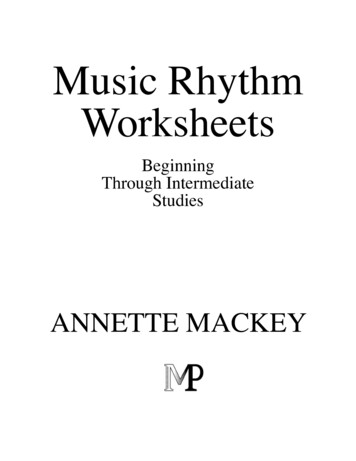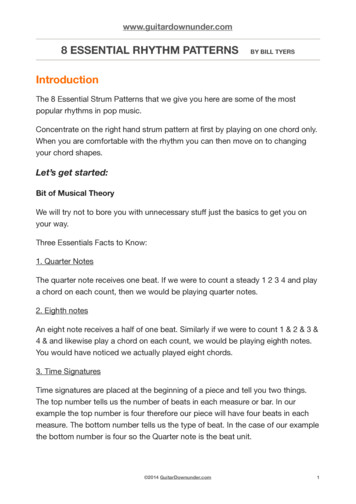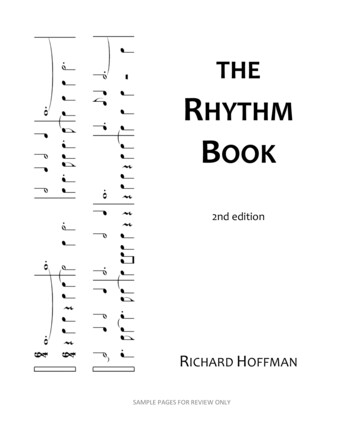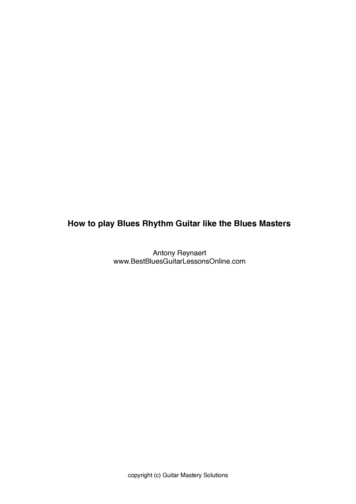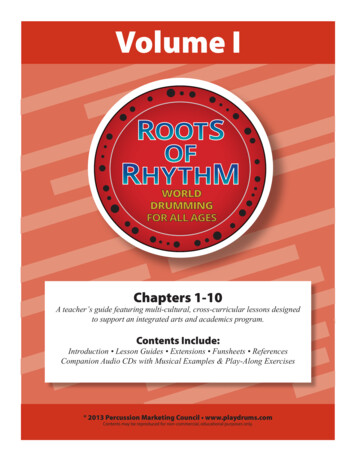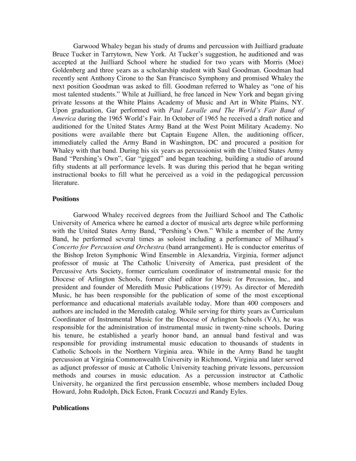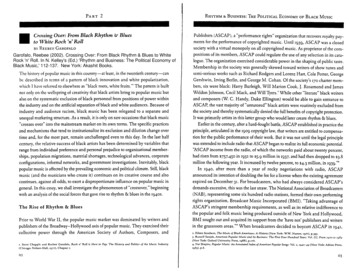
Transcription
RHYTHM& BUSINESS:THEPOLITICALECONOMYOF BLACKMUSICPART2Crossing Over: From Black Rhythmto White Rock ‘n’ RollBY REEBEEGAROFALOBluesGarofalo, Reebee (2002). Crossing Over: From Black Rhythm & Blues to WhiteRock 'n' Roll. In N. Kelley's (Ed.) 'Rhythm and Business: The Political Economy ofBlack Music,' 112-137. New York: Akashit Books.The history of popular music in this country-at least, in the twentieth century-canbe described in terms of a pattern of black innovation and white popularization,which 1 have referred to elsewhere as “black roots, white fruits.’” The pattern is builtnot only on the wellspring of creativity that black artists bring to popular music butalso on the systematic exclusion of black personnel from positions of power withinthe industry and on the artificial separation of black and white audiences. Because ofindustry and audience racism, black music has been relegated to a separate andunequal marketing structure. As a result, it is only on rare occasions that black music“crosses over’’ into the mainstream market on its own terms. The specific practicesand mechanisms that tend to institutionalize its exclusion and dilution change overtime and, for the most part, remain unchallenged even to this day. In the last halfcentury, the relative success of black artists has been determined by variables thatrange from individual preference and personal prejudice to organizational memberships, population migrations, material shortages, technological advances, corporateconfigurations, informal networks, and government investigations. Inevitably, blackpopular music is affected by the prevailing economic and political climate. Still, blackmusic (and the musicians who create it) continues on its creative course and alsocontinues, against all odds, to exert a disproportionate influence on popular music ingeneral. In this essay, we shall investigate the phenomenon of “crossover,”beginningwith an analysis of the social forces that gave rise to rhythm & blues in the 1940s.The Rise of Rhythm & BluesPrior to World War 11, the popular music market was dominated by writers andpublishers of the Broadway-Hollywood axis of popular music. They exercised theircollective power through the American Society of Authors, Composers, andI . Steve Chapple and Reebee Garofalo, Rock n’ Roll is Here to Pay: The History and Politics of the Music Industry(Chicago: Nelson-Hall, 1977). Chapter 7.112.Publishers (ASCAP), a “performance rights” organization that recovers royalty payments for the performance of copyrighted music. Until 1939,ASCAP was a closedsociety with a virtual monopoly on all copyrighted music. As proprietor of the compositions of its members, ASCAP could regulate the use of any selection in its catalogue. The organization exercised considerable power in the shaping of public taste.Membership in the society was generally skewed toward writers of show tunes andsemi-serious works such as Richard Rodgers and Lorenz Hart, Cole Porter, GeorgeGershwin, Irving Berlin, and George M. Cohan. Of the society’s 170charter members, six were black: Harry Burleigh, Will Marion Cook, J. Rosamond and JamesWeldon Johnson, Cecil Mack, and Will Tyers.’ While other “literate” black writersand composers (W. C. Handy, Duke Ellington) would be able to gain entrance toASCAP, the vast majority of “untutored” black artists were routinely excluded fromthe society and thereby systematically denied the full benefits of copyright protection.It was primarily artists in this latter group who would later create rhythm & blues.Earlier in the century, after a hard-fought battle, ASCAP established in practice theprinciple, articulated in the 1909 copyright law, that writers are entitled to compensation for the public performance of their work. But it was not until the legal principlewas extended to include radio that ASCAP began to realize its full economic potential.“ASCAPincome from the radio, of which the networks paid about twenty percent,had risen from 757,450 in 1932to 5.9 million in 1937, and had then dropped to 3.8million the following year. It increased by twelve percent, to 4.3 million, in 1939.”3In 1940, after more than a year of rocky negotiations with radio, ASCAPannounced its intention of doubling the fee for a license when the existing agreementexpired on December 31. For broadcasters, who had always considered ASCAP’sdemands excessive, this was the last straw. The National Association of Broadcasters(NAB), representing some six hundred radio stations, formed their own performingrights organization, Broadcast Music Incorporated (BMI). “Taking advantage ofASCAP’s stringent membership requirements, as well as its relative indifference tothe popular and folk music being produced outside of New York and Hollywood,BMI sought out and acquired its support from the ‘have not’ publishers and writersin the grassroots .”4areas When broadcasters decided to boycott ASCAP in 1941,2. Eileen Southern, The Music of Black Americans: A History ( N e w York: W.W. Norton, 1971). p.353.3. Russell Sanjek, American Popular Music and Its Business: The First Four Hundred Years: Vol.III. From rgoo to 1984(New York: Oxford University Press, 1988). p.176.4. Nat Shapiro, Popular Music: An Annotated Index of American Popular Songs: Vol.2, 1940-49 (New York: Adrian Press,1965). p.6.113
P A R T2BMI was ready with a catalogue of its own. For the next ten months the UnitedStates was treated to an earful of its own root music. Authentic regional styles werebroadcast to 3 mass public intact, not yet boiled down in the national pop meltingpot. Though in its initial stages BMI came up W ith few songs of lasting significance,the Broadway-Hollywood monopoly on popular music was challenged publicly forthe first time. Without this challenge, we might never have heard from composerslike Huddie Ledbetter, Arthur (Big Boy) Crudup, Roy Brown, Ivory Joe Hunter,Johnny Otis, Fats Domino, and Wynonie Harris.The success of these artists testifies to what critic Nelson George has referred to as“an aesthetic schism between high-brow, more assimilated black styles and workingclass, grassroots sounds” that had existed in the black community for a long time.5 Anumber of writers, notably Amiri Baraka (Leroi Jones), have written at length aboutclass differences between jazz and the blues. While jazz was unquestionably animmensely popular and influential crossover music that introduced elements of theAfrican-American tradition into the mainstream, it was also in some ways a productof the black middle class. Many of its most notable practitioners such as DukeEllington, Coleman Hawkins, and Fletcher Henderson were college educated. Bythe thirties it was a music that had “moved away from the older lowdown forms ofblues . . . a music that still relied on [an] older Afro-American musical tradition, butone that had begun to utilize still greater amounts of popular American music as wellas certain formal European traditions,”6 The artists who pioneered rhythm & blues inthe forties were much closer to their blues roots. While they often retained somesemblance of the big-band sound, their initial popularity in the black communityrepresented, in many ways, a resuscitation of the “race”-record market of the twenties and thirties. “While the term ‘jazz’ gave Whiteman equal weight with Ellington,and Bix Beiderbecke comparable standing with Louis Armstrong,” writes NelsonGeorge, “the term ‘race’ was applied to forms of black music-primarily blues-thatwhites and, again, the black elite disdained.”’ The race records of the twenties andthirties sold well, but primarily in regional markets.The creation of a national audience for this regional music was aided significantlyby the population migrations associated with World War II. Eastern andMidwestern GIs, who were stationed in Southern military bases, were exposed to5. Nelson George, The Death of RhythmBluer (New York: Pantheon Books, 1988). p.176.6. Leroi Jones. Blues People (New York: William Morrow, 1963). p.160.7. George. The Death of Rhythm Blues. p.9.I114RHYTHM& BUSINESS:THEPOLITICALECONOMYOF BLACKMUSICmusical styles that had not yet become popular in the North. At the same time, largenumbers of Southern African-Americans moved north and west to find work indefense plants, and they brought their music with them. In the forties, more than onemillion black people left the South, three times as many as the decade before. Newlyemigrated African-Americans had enough money from wartime prosperity to establish themselves as an identifiable consumer group. In areas that received a high concentration of black immigrants, it was in the interest of radio stations to introducesome programming that would cater to this new audience. Gradually, some blackoriented programs, usually slotted late at night, began to appear on a few stations. Itwas this kind of “specialty” programming that would begin to tear down the walls ofthe race market at the end of the decade.Having already alienated the music-publishing establishment of the day, thebroadcasters-which is to say, radio-managed to arouse the anger of establishedmusicians as well. The period before the end of World War II was the era of bigbands, fancy ballrooms, and, most important for the musicians, live music on theradio. Radio was, in essence, their electronic ballroom; it provided very steady work.By and large, live music on radio meant live music performed by white musicians. Asa rule, black musicians were barred from radio performances. Of course, there wereexceptions, such as:live broadcasts of Duke Ellington at the Cotton Club and Chick Webb at the Savoyin Harlem, Earl [Fatha] Hines from Chicago’s Grand Terrace, or maybe a late setfrom some California band from the West Coast Cotton Club. Significantly, thesebroadcasts weren’t aimed at blacks. Broadcasters and advertisers were simply meeting America’s demand for big-band music. These bands just happened to be blackand popular.*In the forties, radio began to experiment with programming recorded music. Themusicians were not about to surrender their best gig to records without a fight. In1942the American Federation of Musicians (AFM) struck the major record labelsand ordered a ban on recording. Months later, the musicians returned to the studiosto find vocalists in charge. Vocalists belong to a different union-currently called the8. Ibid. p.11.
PART 2American Federation of Television and Radio Artists (AFTRA)-and AFTRA didnot join the strike. The AFM itself thus aided the rise of solo vocalists, who werenow becoming the main attraction of the big bands, by allowing them free rein in therecording studios. With the rise of vocalists, the pop charts were gradually taken overby such figures as Bing Crosby, Perry Como, Dinah Shore, Vaughn Monroe,Frankie Laine, Doris Day, Jo Stafford, and, of course, Frank Sinatra. Throughout thepost-war forties the onlv black vocal acts to make the year-end pop charts were themore pop-sounding artists like Nat “King” Cole (“For Sentimental Reasons”), EllaFitzgerald (“My Happiness”), the Mills Brothers (‘Across the Valley from theAlamo”), and the Ink Spots (“The Gypsy”). There were never more than two blackvocalists on the year-end charts in a given year.If the rise of the solo vocalist was a psychological blow to the big bands, it was thepost-war economy that dealt the death blow. After the war, it was no longer feasibleto support the elaborate production of twenty-piece orchestras as a regular attraction.Ballrooms disappeared and, unable to find steady work, the big bands graduallybroke up. The black big bands, which had provided much of the impetus for the bigband sound, limped along for a while on one-nighters on the dying dance-hall circuit. The better-known black bands, like Count Basie’s band and Duke Ellington’s,could also count on an occasional hit record such as Basie’s recording of “Open theDoor, Richard” for Victor, which made the year-end pop charts in 1947. Still, it wasclear by then that a musical era in the United States had come to an end, and it wasreflected in record sales. Between 1947 and 1949 sales dropped off more than fiftymillion dollars, which at the time represented more than twenty percent of the dollarvolume of the industry. The situation was worse for black artists. By the end of thedecade not a single black performer could be found on the year-end pop charts.The population migrations previously mentioned opened the possibility of anationwide market for black music, which did not exist prior to World War II. Themajor companies never exploited this new market during the war because a shellacshortage caused significant cutbacks in the number of records that could be manufactured. Shellac was the principal ingredient used in making the old 78rpm records.During the Pacific blockade it became almost impossible to obtain the material fromIndia where it is secreted by a tree-crawling insect. At the height of the shortage, inorder to buy a new record it was often necessary to return an old one so that it couldbe recycled. Since the pop-music market alone was capable of absorbing virtually all116RHYTHM& BUSINESS:THEPOLITICALECONOMYOF BLACKMUSICthe records that could be produced, the major labels concentrated their efforts there.The specialty fields, especially blues, jazz, and gospel, bore the brunt of the cutbacks,and were essentially abandoned by the major labels.Whereas the shellac shortage had seriously limited the supply of specialty music,cross-cultural contact had, if anything, increased the demand. Thus, after the warended, the major companies tried to regain control of the specialty markets. In thecountry & western field this proved to be relatively simple. According to pop historian Charlie Gillett:[T]he companies responded by heavily promoting various songs performed in versions of country & western styles. One tactic was to promote the strong Southernaccent of most country & western singers as a “novelty,” as Capitol d
PART 2 Crossing Over: From Black Rhythm Blues to White Rock ‘n’ Roll BY REEBEE GAROFALO The history of popular music in this country-at least, in the twentieth century-can be described in terms of a pattern of black innovation and white popularization, which 1 have referred to elsewhere as “black roots, white fruits.’”The pattern is built
